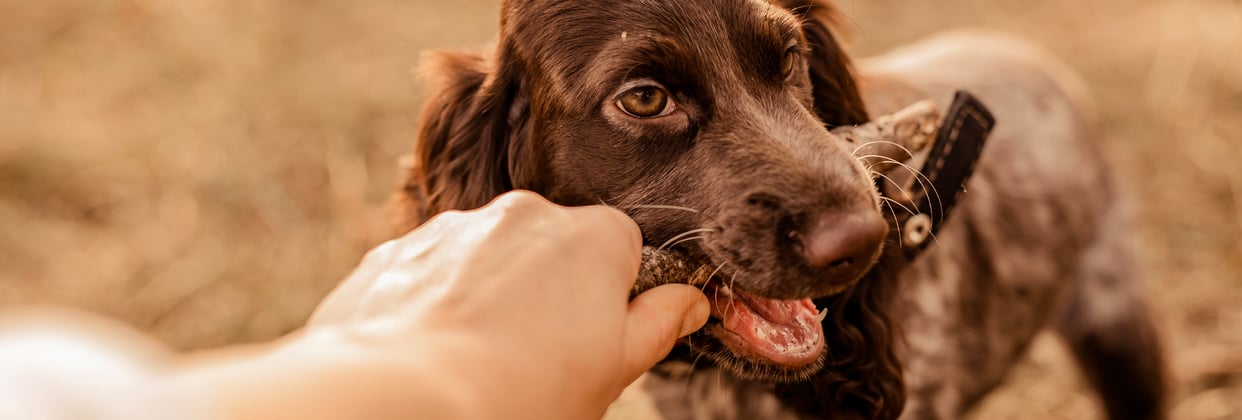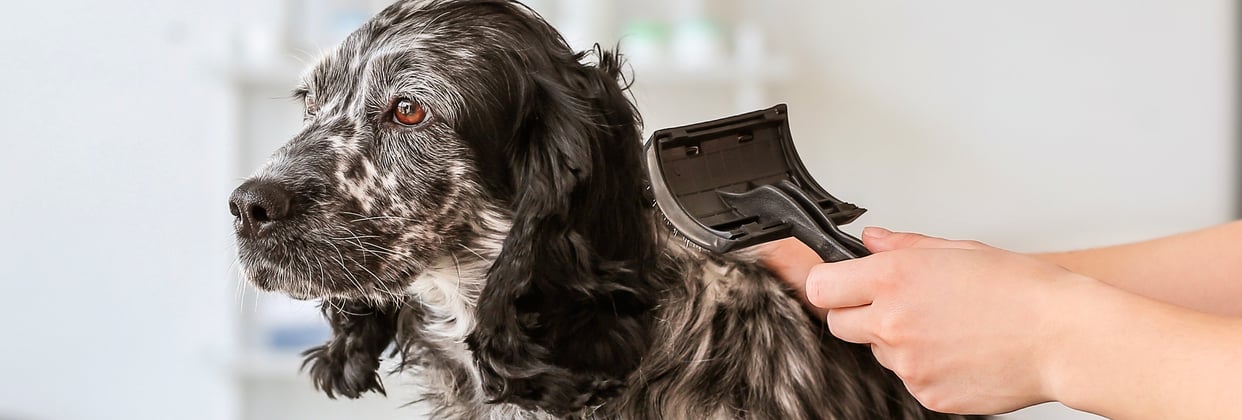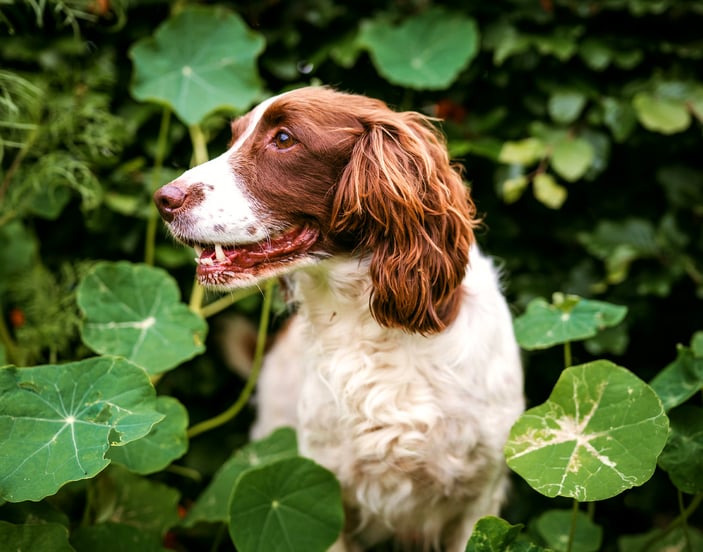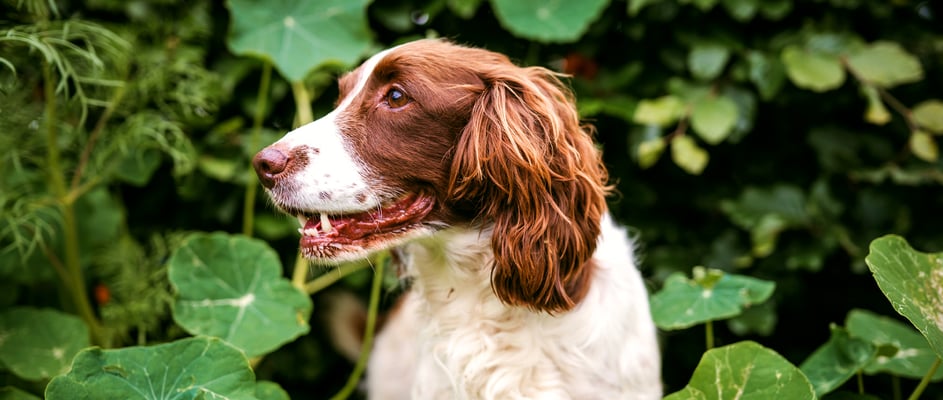The guide to owning a Sprocker Spaniel.
Want to know everything there is to know about training your Sprocker Spaniel puppy? Submit your email below, and we’ll send you a one-stop guide on all things puppy training!
Jump to:
Stats at a glance.
History of the Sprocker Spaniel.
The Sprocker Spaniel is a lovable cross between two sporting dynamos, the Cocker Spaniel and the English Springer Spaniel. This cross is often called a “designer dog,” but don’t let that term fool you.
Historically, Sprockers emerged from selective breeding in British gundog circles, aiming to produce healthy, loyal dogs with the retrieving skills of both Springer and Cocker.
Their canine ancestors were prized for loyalty, intelligence, and stamina. Together, Cocker Spaniels and Springer Spaniels created a hybrid that loves fieldwork just as much as curling up by the sofa.
With the Kennel Club officially recognising both the Cocker Spaniel and the English Springer Spaniel as separate purebreds, the Sprocker isn't “official” in the same sense, but many enthusiasts believe their combination results in some of the most loving and intelligent dogs around.
Feeling curious about other spaniels? Visit our Cocker Spaniel Breed Guide to see how their cousins compare.


How much is a Sprocker Spaniel puppy (UK)?
Planning on adding a Sprocker puppy to your family? In the UK, you might pay around £500–£1,500, depending on pedigree, coat colour, parent health checks, and breeder reputation.
Some folks might find Sprocker puppies for sale online in more rare and special colours (for instance, a Chocolate Sprocker), which can influence the price tag.
We recommend doing thorough research. Ask how the pups are raised. Ensure you see both mum and dad if possible. If you’re new to dog ownership, you’ll want that guiding hand a great breeder provides.
If you’d like more insight into raising a puppy right from the start, check out our helpful tips on Crate Training a Cocker Spaniel. A method that works well for Sprocker Spaniels, too.
Colours and coat types.
Because Sprockers come from Cocker and the Springer Spaniel, you’ll see a range of colours. The classics include liver and white, black and white, or solid liver or black. Some lines even produce merle coats but these are less common. Their coats are often silky, medium-length, and moderately water-resistant.
Typical colours:
Speckled or roan (from the English Springer side).
Solid black or liver (common in both parent breeds).
Tri-colour or merle (less frequent, but eye-catching).
Mixture of any of these.
Coat care:
Sprockers often inherit a wavy or slightly feathered coat. Brushing a few times a week helps prevent knots and keep them looking tidy.
If you’re keen on seeing more gorgeous spaniel varieties, take a look at our guide to Spaniel Breeds.





Size and weight.
Sprockers usually stand taller than purebred Cockers but a bit shorter than most Springers.
In general:
Height: 32–40 cm at the shoulder
Weight: 14–20 kg
Both sexes are muscular yet agile. You’ll notice a sporty stance that hints at their working dog heritage. They’re not too big, but they’re certainly robust enough to keep up on long walks or field days.


Temperament and behaviour.
Are Sprocker Spaniels good pets?
Absolutely. The Sprocker Spaniel temperament is typically cheerful, energetic, and eager to please.
These crossbreed pups are soulful companions that thrive on family time. With natural retrieving instincts, they often love a good game of fetch or rummaging in the undergrowth.
Are Sprocker Spaniels good with kids?
Yes, provided they’re well-socialised and taught gentle manners. We encourage families to supervise play, as energetic dogs can get boisterous.
Young children should learn how to interact respectfully which means no tugging ears or pulling tails.
A Sprocker that’s grown up around children will often become a doting companion and great family pet.
Curious if other spaniel varieties fit your family? Check out Are Cocker Spaniels Good Family Dogs.
Are Sprocker Spaniels good with cats?
It’s possible. Many dog owners find that early socialisation is the magic ingredient. If a Sprocker grows up with a cat from kittenhood, they can be best buds.
But remember, that gun dog heritage means they can be excited by small, fast-moving creatures. Slow introductions and patience help harmony bloom.


Do Sprocker Spaniels suffer from separation anxiety?
These are active dogs who adore their people. They can experience stress when left alone too long, especially if they’re under-exercised.
Early training and practice in short separations can help. If you notice signs of anxiety, such as destructive chewing or whining, you might need extra strategies.
Can Sprocker Spaniels be left alone?
For short periods, yes. We suggest no longer than 4–6 hours, ideally. They do best with mental stimulation like treat puzzles or playtime before you leave. If you must be out for a full workday, consider a dog walker, doggy daycare, or a family member’s help.
Can Sprocker Spaniels live in apartments?
These pups can adapt, but they need lots of exercise. If you’re in a flat, daily walks (at least two decent ones) plus quick potty breaks are essential.
Sprockers also benefit from off-lead sprints in safe areas. Apartment living is possible, but you’ll have a happier dog if you’re near parks or green spaces.
Do Sprocker Spaniels bark a lot?
They can be vocal if bored. Expect them to alert you to visitors, squirrels, or that odd leaf blowing across the window. Good training and sufficient daily activity help moderate any excessive barking.
Training a Sprocker Spaniel.
Are Sprocker Spaniels smart?
Extremely. Sprockers are intelligent and known for their “eager to please” attitude. Still, they can be wilful if they don’t see the point in an exercise.
Keep sessions upbeat, and use positive rewards such as treats, praise, and play in order to hold their attentive gaze. Avoid harsh methods; they respond best to encouragement.


Shedding and grooming.
How often should I brush my Sprocker Spaniel?
At least 2–3 times weekly. Longer feathers on the ears and tail can mat if ignored. Moderate shedding occurs year-round, but more brushing keeps hair in check. During muddy adventures, a quick rinse may be necessary, especially their feathered legs and undercarriage.


Exercise needs.
Don’t let a Sprocker Spaniel fool you with those puppy-dog eyes; they can go and go. Typically, they need 60–90 minutes of exercise daily, which might include:
Walks, jogs, or hikes (while staying mindful of busy roads).
Off-lead romps in secure areas to satisfy their flushing and retrieving instincts.
Interactive games like hide-and-seek or treasure hunts with treats.
They also love agility training, which engages their brains and bodies. If you’re a runner, they’ll often keep pace for shorter distances.
As with any breed, start gently and build up to more vigorous activity to protect their joints.


Feeding and nutrition.
Keeping these energetic dogs well-fuelled is key. Quality, balanced dog food divided into two meals a day often works best.
Portion size varies by age, weight, and lifestyle. Watch their waistline as an overweight Sprocker can strain its joints and back.
If you’re curious how diet relates to overall spaniel health, have a quick read of Understanding Cocker Spaniel Health Issues. Many dietary considerations overlap with Sprockers, especially since the two parent breeds share health and nutritional needs.
Common health issues in Sprocker Spaniels.
Like any dog, Sprockers have a few conditions to watch out for. Below is a rough table offering potential costs:
Note: Costs are approximate and can vary based on location and specific veterinary practices.
Routine vet checks are your best ally. An early chat with a veterinary professional can spot issues before they escalate. Regular eye, ear, and joint evaluations ensure your Sprocker stays in tip-top shape.


Pet insurance for Sprocker Spaniels.
Because Sprockers are prone to a few hereditary issues, solid coverage can protect you from surprise bills. Having peace of mind means you can focus on playing fetch, not fretting over costs.
At Waggel, we offer:
Lifetime coverage for chronic conditions
Support for breed-specific conditions
Online vet advice
Behaviour, nutrition, and mental wellbeing support
Simple, transparent claims
Get your Sprocker Spaniel pet insurance quote today. It’s an option many families find invaluable, especially with these busy, curious pups that never let a muddy puddle go unexplored.
A Sprocker Spaniel is a bundle of love, energy, and unwavering devotion. Whether you’re out trekking rugged trails or enjoying lazy Sunday snuggles, you’ll rarely find a dull moment with these exuberant companions.
Keep them well socialised, invest time in training, and ensure their boundless energy finds an outlet. In return, you’ll discover a best friend who’ll stick by your side through every new adventure.


